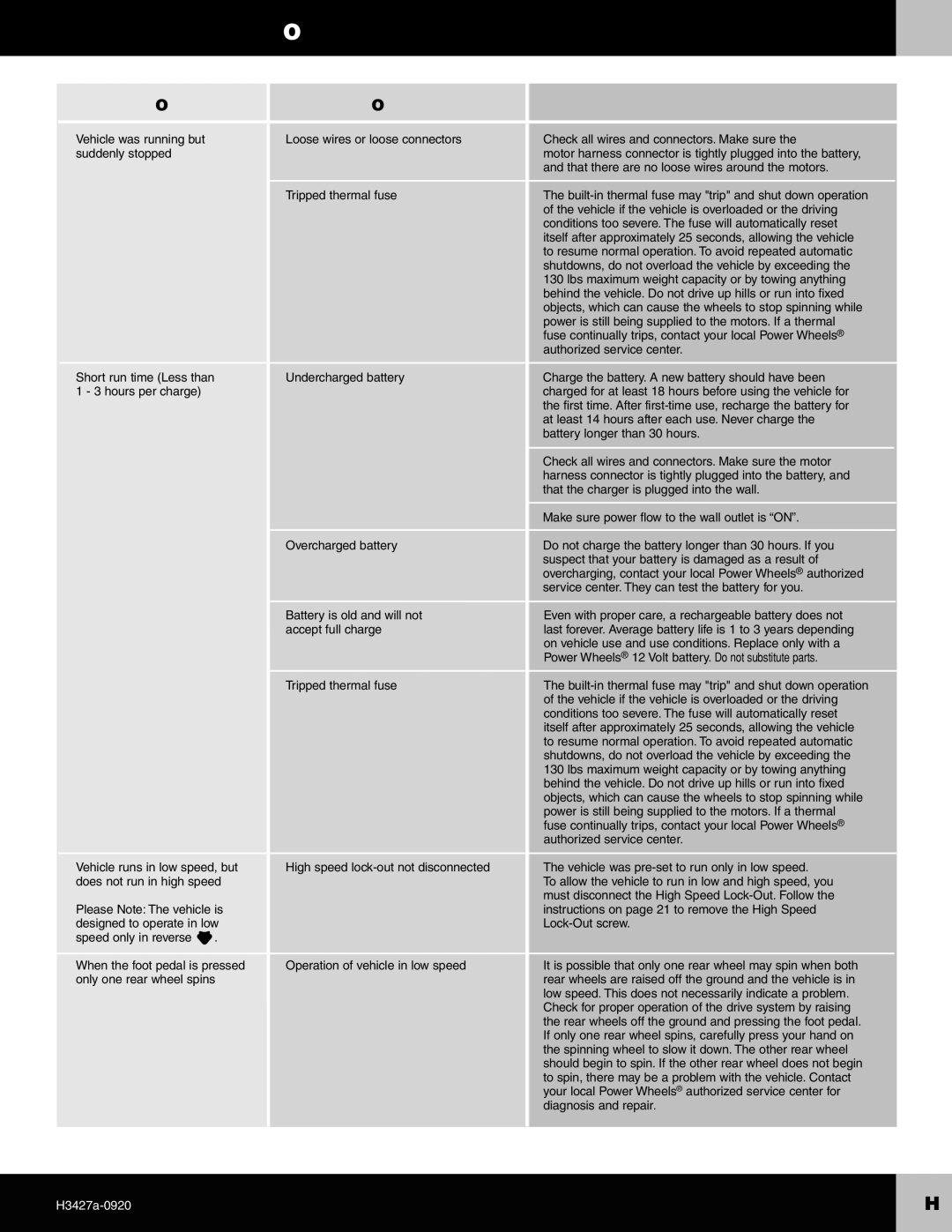
PROBLEMS AND SOLUTIONS GUIDE | P |
PROBLEM | POSSIBLE CAUSE | SOLUTION | |
Vehicle was running but |
| Loose wires or loose connectors | Check all wires and connectors. Make sure the |
suddenly stopped |
|
| motor harness connector is tightly plugged into the battery, |
|
|
| and that there are no loose wires around the motors. |
|
| Tripped thermal fuse | The |
|
|
| of the vehicle if the vehicle is overloaded or the driving |
|
|
| conditions too severe. The fuse will automatically reset |
|
|
| itself after approximately 25 seconds, allowing the vehicle |
|
|
| to resume normal operation. To avoid repeated automatic |
|
|
| shutdowns, do not overload the vehicle by exceeding the |
|
|
| 130 lbs maximum weight capacity or by towing anything |
|
|
| behind the vehicle. Do not drive up hills or run into fixed |
|
|
| objects, which can cause the wheels to stop spinning while |
|
|
| power is still being supplied to the motors. If a thermal |
|
|
| fuse continually trips, contact your local Power Wheels® |
|
|
| authorized service center. |
Short run time (Less than | Undercharged battery | Charge the battery. A new battery should have been | |
1 - 3 hours per charge) |
|
| charged for at least 18 hours before using the vehicle for |
|
|
| the first time. After |
|
|
| at least 14 hours after each use. Never charge the |
|
|
| battery longer than 30 hours. |
|
|
| Check all wires and connectors. Make sure the motor |
|
|
| harness connector is tightly plugged into the battery, and |
|
|
| that the charger is plugged into the wall. |
|
|
| Make sure power flow to the wall outlet is “ON”. |
|
| Overcharged battery | Do not charge the battery longer than 30 hours. If you |
|
|
| suspect that your battery is damaged as a result of |
|
|
| overcharging, contact your local Power Wheels® authorized |
|
|
| service center. They can test the battery for you. |
|
| Battery is old and will not | Even with proper care, a rechargeable battery does not |
|
| accept full charge | last forever. Average battery life is 1 to 3 years depending |
|
|
| on vehicle use and use conditions. Replace only with a |
|
|
| Power Wheels® 12 Volt battery. Do not substitute parts. |
|
| Tripped thermal fuse | The |
|
|
| of the vehicle if the vehicle is overloaded or the driving |
|
|
| conditions too severe. The fuse will automatically reset |
|
|
| itself after approximately 25 seconds, allowing the vehicle |
|
|
| to resume normal operation. To avoid repeated automatic |
|
|
| shutdowns, do not overload the vehicle by exceeding the |
|
|
| 130 lbs maximum weight capacity or by towing anything |
|
|
| behind the vehicle. Do not drive up hills or run into fixed |
|
|
| objects, which can cause the wheels to stop spinning while |
|
|
| power is still being supplied to the motors. If a thermal |
|
|
| fuse continually trips, contact your local Power Wheels® |
|
|
| authorized service center. |
Vehicle runs in low speed, but | High speed | The vehicle was | |
does not run in high speed |
| To allow the vehicle to run in low and high speed, you | |
|
|
| must disconnect the High Speed |
Please Note: The vehicle is |
| instructions on page 21 to remove the High Speed | |
designed to operate in low |
| ||
speed only in reverse | . |
|
|
When the foot pedal is pressed | Operation of vehicle in low speed | It is possible that only one rear wheel may spin when both | |
only one rear wheel spins |
| rear wheels are raised off the ground and the vehicle is in | |
|
|
| low speed. This does not necessarily indicate a problem. |
|
|
| Check for proper operation of the drive system by raising |
|
|
| the rear wheels off the ground and pressing the foot pedal. |
|
|
| If only one rear wheel spins, carefully press your hand on |
|
|
| the spinning wheel to slow it down. The other rear wheel |
|
|
| should begin to spin. If the other rear wheel does not begin |
|
|
| to spin, there may be a problem with the vehicle. Contact |
|
|
| your local Power Wheels® authorized service center for |
|
|
| diagnosis and repair. |
25 |
